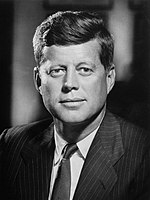| ||||||||||||||||||||||||||
| ||||||||||||||||||||||||||
 County Results
| ||||||||||||||||||||||||||
| ||||||||||||||||||||||||||
| Elections in Tennessee |
|---|
 |
|
|
The 1960 United States presidential election in Tennessee took place on November 8, 1960, as part of the 1960 United States presidential election. Tennessee voters chose 11[2] representatives, or electors, to the Electoral College, who voted for president and vice president.
Ever since the Civil War, Tennessee’s white citizenry had been divided according to political loyalties established in that war. Unionist regions covering almost all of East Tennessee, Kentucky Pennyroyal-allied Macon County, and the Western Highland Rim counties of Carroll, Henderson, McNairy, Hardin and Wayne[3] voted Republican — generally by landslide margins — as they saw the Democratic Party as the "war party" who had forced them into a war they did not wish to fight.[4] Contrariwise, the rest of Middle and West Tennessee who had supported and driven the state's secession were equally fiercely Democratic as it associated the Republicans with Reconstruction.[5] The Democratic Party was certain of winning statewide elections if united,[6] although unlike the Deep South Republicans would almost always gain thirty to forty percent of the statewide vote from mountain and Highland Rim support even after most blacks were disenfranchised around 1890 by a poll tax[7] and intimidation.
Between 1896 and 1948, the Republicans would win statewide contests three times but only in the second amiss the national anti-Wilson tide of 1920[8] did they receive down-ballot coattails by winning three congressional seats in addition to the rock-ribbed GOP First and Second Districts.[9] After the beginning of the Great Depression, however, for the next third of a century the Republicans would rarely contest statewide offices seriously despite continuing dominance of East Tennessee and half a dozen Unionist counties in the middle and west of the state.[10] State GOP leader B. Carroll Reece is widely believed to have had agreements with E. H. Crump and later Frank G. Clement and Buford Ellington that Republicans would not contest offices statewide or outside their traditional pro-Union areas.[11] Despite this, the capture of a substantial part of the West Tennessee Dixiecrat vote of 1948 allowed Dwight D. Eisenhower to narrowly carry the state for the GOP in both 1952[12] and 1956.
For 1960, the nomination of Irish Catholic John F. Kennedy by the Democratic Party — who had made major gains in the 1958 midterm elections — led to severe questioning of how Tennessee’s heavily fundamentalist electorate would react to Kennedy’s Catholicism.[13]
- ^ "United States Presidential election of 1960 – Encyclopædia Britannica". Retrieved June 7, 2017.
- ^ "1960 Election for the Forty-Fourth Term (1961-65)". Retrieved June 7, 2017.
- ^ Wright, John K. (October 1932). "Voting Habits in the United States: A Note on Two Maps". Geographical Review. 22 (4): 666–672. doi:10.2307/208821. JSTOR 208821.
- ^ Key (Jr.), Valdimer Orlando; Southern Politics in State and Nation (New York, 1949), pp. 282-283
- ^ Lyons, William; Scheb (II), John M.; Stair, Billy (2001). Government and Politics in Tennessee. pp. 183–184. ISBN 1572331410.
- ^ Grantham, Dewey W. (Fall 1995). "Tennessee and Twentieth-Century American Politics". Tennessee Historical Quarterly. 54 (3): 210–229.
- ^ Phillips, Kevin P.; The Emerging Republican Majority, pp. 208, 210 ISBN 9780691163246
- ^ Reichard, Gary W. (February 1970). "The Aberration of 1920: An Analysis of Harding's Victory in Tennessee". The Journal of Southern History. 36 (1): 33–49. doi:10.2307/2206601. JSTOR 2206601.
- ^ Phillips; The Emerging Republican Majority, p. 287
- ^ Majors, William R. (1986). Change and continuity: Tennessee politics since the Civil War. p. 72. ISBN 9780865542099.
- ^ Vile, John R.; Byrnes, Mark Eaton, eds. (1998). Tennessee government and politics: democracy in the volunteer state. pp. 2–3. ISBN 0826513093.
- ^ Strong, Donald S. (August 1955). "The Presidential Election in the South, 1952". The Journal of Politics. 17 (3). The University of Chicago Press: 343–389. doi:10.1017/S0022381600091064. S2CID 154634842.
- ^ Phillips; The Emerging Republican Majority, p. 221
© MMXXIII Rich X Search. We shall prevail. All rights reserved. Rich X Search


